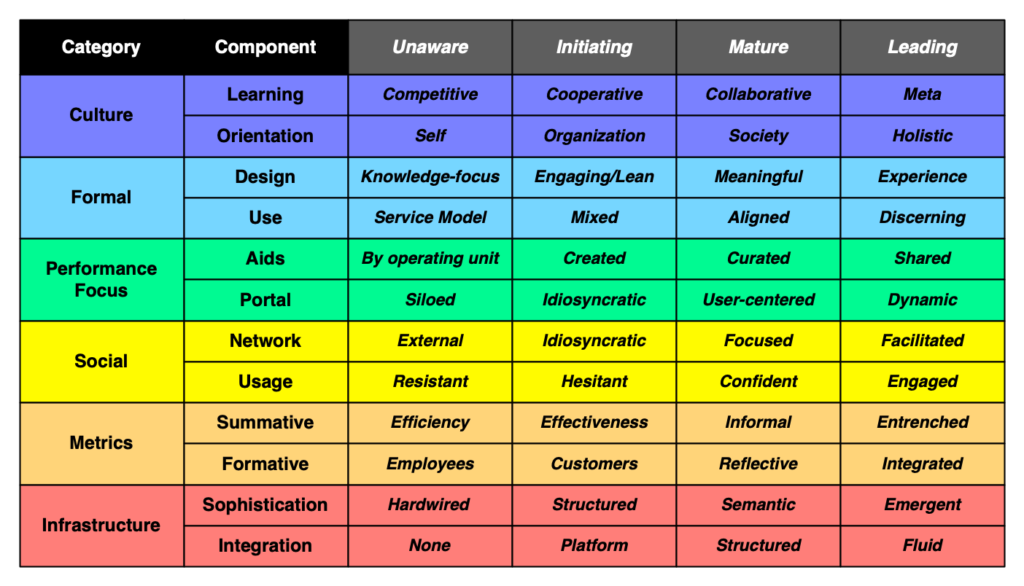
Performance Ecosystem Maturity Model
Author: Clark
Go to Source
Someone on LinkedIn asked about a way to evaluate orgs on their learning infrastructure. And I had developed a Performance Ecosystem Maturity Model as part of Revolutionize Learning & Development, but…I hadn’t presented it. At least not in full. Here I rectify that; my holiday gift to you!
(A bit over 5 mins.) And, of course, the prose (and the diagram):
Script
Hi, I’m Clark Quinn, of Quinnovation. Recently, someone asked about an organizational learning maturity model. And, coincidentally, I had one. However, it was locked away in my book from 2018. So I want to present that model, and hope it’s of use.
In my book, Revolutionize Learning & Development, I pushed for the performance ecosystem, going beyond ‘the course’ to talk about all the ways that L&D that could assist organizational learning. I posit that optimal execution is only the cost of entry, and the only sustainable differentiator is continual innovation. And I argued for what that meant. I want organizations to have a concrete picture of what this looked like.
 In the book I had a set of six categories, each with two components. So I created a ‘maturity model’. The intent is to provide a tool whereby organizations can understand what the possibilities are, assess themselves, and prioritize directions to move and improve. Let’s be clear, this is conceptual, not empirical. This is a proposal about what should be the elements, and an effort to consider what fits in each stage of each component.
In the book I had a set of six categories, each with two components. So I created a ‘maturity model’. The intent is to provide a tool whereby organizations can understand what the possibilities are, assess themselves, and prioritize directions to move and improve. Let’s be clear, this is conceptual, not empirical. This is a proposal about what should be the elements, and an effort to consider what fits in each stage of each component.
The first area is culture. How we’re learning, and what our orientation is. And you’ll see as we fill out the table, what this means. Starting with learning, we transition from a competitive environment, (which is unhealthy), through being willing to cooperate (say for team projects), to where we’re collaborating of our own initiative, ending up where we’re working to also improve our processes as well as our outcomes. And our orientation shifts from learning for our own benefit, to learning as an organization, then to where we consider the impacts on society, ending up where we’re looking to ensure this works across those elements.
Then we look at the formal learning elements, how we design and who’s using the learning. We start with the traditional knowledge dump, then on making it more engaging and lean, to where we’re focusing on making it meaningful to the org and the individual, and finally creating transformative experiences. And we look at who’s using the learning. It starts with taking orders for courses, through having some times where the effort is to truly address a need, to where our efforts are aligned with key organizational needs, and finally where we’re being discerning about methods, measures, and outcomes.
We then consider going beyond the course to times when knowledge can be in the world, not in the head. We worry about resources and the ways people can get access to them. Instead of idiosyncratic aids, we move to having L&D creating support, and then recognizing the value of curation, and finally with a mixed initiative with everyone contributing. And we move from the siloed access to these resources, through an intermediate stage of some focused development, to a user-centric access based upon the users needs (not the originators location), ending at a dynamic matching of need to resource.
We also start looking at informal learning, the continual innovation. This includes both the status of networks and the usage of those networks. It starts where if there’s network usage, it’s not org-originated, through some units having a system, to having an organizational focus on communication, and then actively facilitating social learning. And we move from the Miranda organization (where anything you say can and will be used against you), to where some folks are experimenting, to where people are comfortable contributing, and finally where folks recognize that active engagement is key to organizational thrival.
We also consider the use of metrics in the organization, both to evaluate and to improve. We should move from just looking at the cost of a butt in a seat for an hour to whether that time is benefiting the org. Then we incorporate informal learning, and finally where measurement’s naturally part of our practices. We move our focus from internal to a broader picture, and start evaluating our processes themselves, and move to looking at these as a synergistic whole
Finally, we look at our infrastructure, our underlying approach and our systematicity. We move from handcrafted solutions to systemic approaches, then looking to incorporate semantics, and finally looking at systems with emergent capabilities. And we move to look at our approaches as platforms, and then integrate those platforms, and finally allow our systems to adapt as conditions change.
This is an updated version of the model in the book, and I think provides a useful framework for thinking about L&D. I hope this made sense, and is of interest. And I welcome feedback! Thanks for listening. You can find out more at Quinnovation.com, and at revolutionizelnd.com.
The post Performance Ecosystem Maturity Model appeared first on Learnlets.
